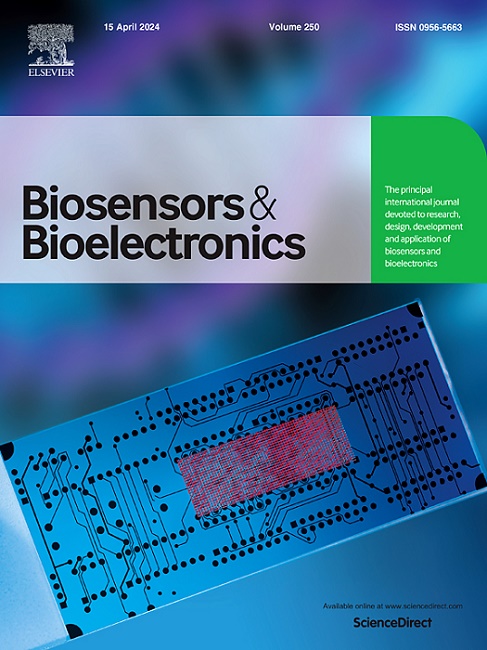悬浮微电极阵列的复合增材制造:先进的定向心肌组织培养和电生理传感
IF 10.5
1区 生物学
Q1 BIOPHYSICS
引用次数: 0
摘要
微电极阵列(MEAs)开创了体外药物筛选和心脏毒性评估的新时代。然而,二维(2D)平面培养的形态限制和传统电极的机械刚性阻碍了心肌组织的形成,这些组织与天然生理条件非常相似,限制了基于电生理信号的药物疗效分析的准确性。在这里,我们提出了一个由复合增材制造方法实现的灵活的MEA平台,其关键步骤包括微纤维的熔体电解、绝缘层的静电喷涂和纳米纤维支架的静电纺丝。本设计将悬浮的柔性微纤维电极与紧密粘附的纳米纤维支架相结合,为心肌组织培养创造了三维有序的培养环境,同时保证了电生理信号的适应性记录。与随机纤维相比,排列的纳米纤维支架促进定向心肌生长,肌节长度增加29%,传播速度达到15.835 cm/s。直径约20 μm的柔性和可拉伸的微纤维电极动态地符合组织在加热过程中的变形。此外,使用异丙肾上腺素和维拉帕米验证了该平台的功能性能,证实了其在芯片上药物筛选应用的潜力。这些结果突出了悬浮的、灵活的和对齐的mea用于芯片上药物筛选的前景。本文章由计算机程序翻译,如有差异,请以英文原文为准。
Composite additive manufacturing for suspended microelectrode arrays: Advancing oriented myocardial tissue culturing and electrophysiological sensing
Microelectrode arrays (MEAs) have ushered in a new era of in vitro drug screening and cardiotoxicity evaluation. However, the morphological constraints of two-dimensional (2D) planar culture and the mechanical rigidity of conventional electrodes hinder the formation of myocardial tissues that closely resemble native physiological conditions and limit the accuracy of drug efficacy analysis based on electrophysiological signals. Here, we present a flexible MEA platform enabled by a composite additive manufacturing approach, with key steps including melt electrowriting of microfibers, electrostatic spraying of insulation layer, and electrospinning of nanofiber scaffolds. This design integrates suspended, flexible microfiber electrodes with tightly adhered nanofiber scaffolds, creating a 3D ordered culture environment for myocardial tissue culture while ensuring adaptable electrophysiological signal recording. The aligned nanofiber scaffolds promote oriented myocardial growth and enhance sarcomere length by 29 % compared to random fibers, resulting in a propagation speed of 15.835 cm/s. The flexible and stretchable microfiber electrodes, approximately 20 μm in diameter, conform dynamically to tissue deformation during beating. Furthermore, the platform's functional performance is validated using isoproterenol and verapamil, confirming its potential for on-chip drug screening applications. These results highlight the promise of the suspended, flexible, and aligned MEAs for on-chip drug screening.
求助全文
通过发布文献求助,成功后即可免费获取论文全文。
去求助
来源期刊

Biosensors and Bioelectronics
工程技术-电化学
CiteScore
20.80
自引率
7.10%
发文量
1006
审稿时长
29 days
期刊介绍:
Biosensors & Bioelectronics, along with its open access companion journal Biosensors & Bioelectronics: X, is the leading international publication in the field of biosensors and bioelectronics. It covers research, design, development, and application of biosensors, which are analytical devices incorporating biological materials with physicochemical transducers. These devices, including sensors, DNA chips, electronic noses, and lab-on-a-chip, produce digital signals proportional to specific analytes. Examples include immunosensors and enzyme-based biosensors, applied in various fields such as medicine, environmental monitoring, and food industry. The journal also focuses on molecular and supramolecular structures for enhancing device performance.
 求助内容:
求助内容: 应助结果提醒方式:
应助结果提醒方式:


